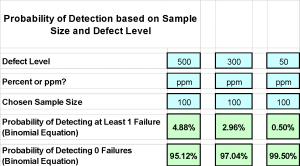Do you often wonder why you can pass Reliability qualification tests with set sample sizes, but still cannot achieve the Reliability levels customers demand??
If you consider AQL tables where sample sizes for achieving nominated Quality levels are set around Accept and Reject defect numbers, the Quality levels such as 0.65% or 6500 ppm are simply NOT acceptable in today’s commercial and consumer market. Often automotive customers will set failure targets in range of 50 ppm, hence sampling to try and achieve this level is simply NOT possible un less quite ‘ENORMOUS’ sample sizes are taken !!
Using the simple binomial distribution based on Probability of detecting 0 or at least 1 defect from a sample of units to achieve a given Quality target, we can easily calculate the required sample sizes;
If Quality target is say 500 ppm and say 100 pcs are tested;
Probability (detecting 0 defects) = 95.12%
Probability (detecting at least1 defect) = 4.88%
As target defect levels reduce, then of course the probability of detecting any defects reduces considerably
Take for example some JEDEC tests where standard sample sizes may be only 77 pcs , hence if a customer wants as low as 10 ppm (often even lower !), probability of finding 0 defects is 99.92%, hence even if there is a ‘latent’ defect waiting to happen, the chance of finding this defect within a THB or HAST test, etc will be almost 0 !!
Hence it is HIGHLY LIKELY that a High Reliability batch of devices / products will perform similarly in low volume batch test to that of a much Poorer Reliability batch, so how can we discriminate between such batches, also a major problem when handling ‘Maverick’ Lots
Qualification tests therefore become ‘tick box’ type tests with limited value add to the producer and high risk to the customer
Obviously the modern approach simply has to change quite radically from tradition as we cannot escape from statistics and the very low likelihood of failures being detected.
To purely rely on sample testing and individual tests of different types is simply NOT going to cut-it in today’s electronics and electro mechanical industries.
Reliability Solutions have developed very different approaches to this challenge and are now providing the models and methods to apply across device and product ranges in its 2019 Training Agenda.
Recently the new agenda was given to a large class in Penang, Malaysia with excellent feedback, here is a snippet or two of what our attendees thought:
| Company | Job Title | What do you like best about the course |
| Flextronics | Director | Provide an overall idea of how to set up reliability test requirement & quantitites way of ensuring the test is suitable & able to detect defects |
| Flextronics | Senior QE | Instructor is very experience and able to give a better insight of reliability |
| Flextronics | QE | n/a |
| Flextronics | Engineering | Instructor able to emphasize the theory to actual scenario in the manufacturing |
| Flextronics | Design Engineer | Case study from real-life examples |
| Flextronics | Process Engineer | The in-depth study on product reliability, eliminate assumptions and quantifying reliability |
| Flextronics System | Design & Development Engineer | Structural training material and training was condusted in relaxing approach |
| WD | Reliability | n/a |
| Laird Technologies | R&D Engineer | Case studies |
| WD | QA | The experience of the instructor. Able to deliver the knowledge in simple way |
| Laird Technologies | R&D Engineer | Case study real life |
| WD | Product Quality | Case study and good work |
| WD | QA | example os case study |
| Laird Technologies | Engineer | Q&A Concept of reliability |
| Laird Technologies | R&D Engineer | workshop |
| WD | Reliability Engineer | Instructor is able to relate actual casesin today industry to REL assessment |
| WD | Reliability Engineer | the simple presentation and easy to understand |
| WD | QA | Execellent. |
If the new 2019 training agenda may interest you or your company email us on reliabilitysolutions@yahoo.co.uk
Or find us on www.reliabilitysolutions.co.uk
